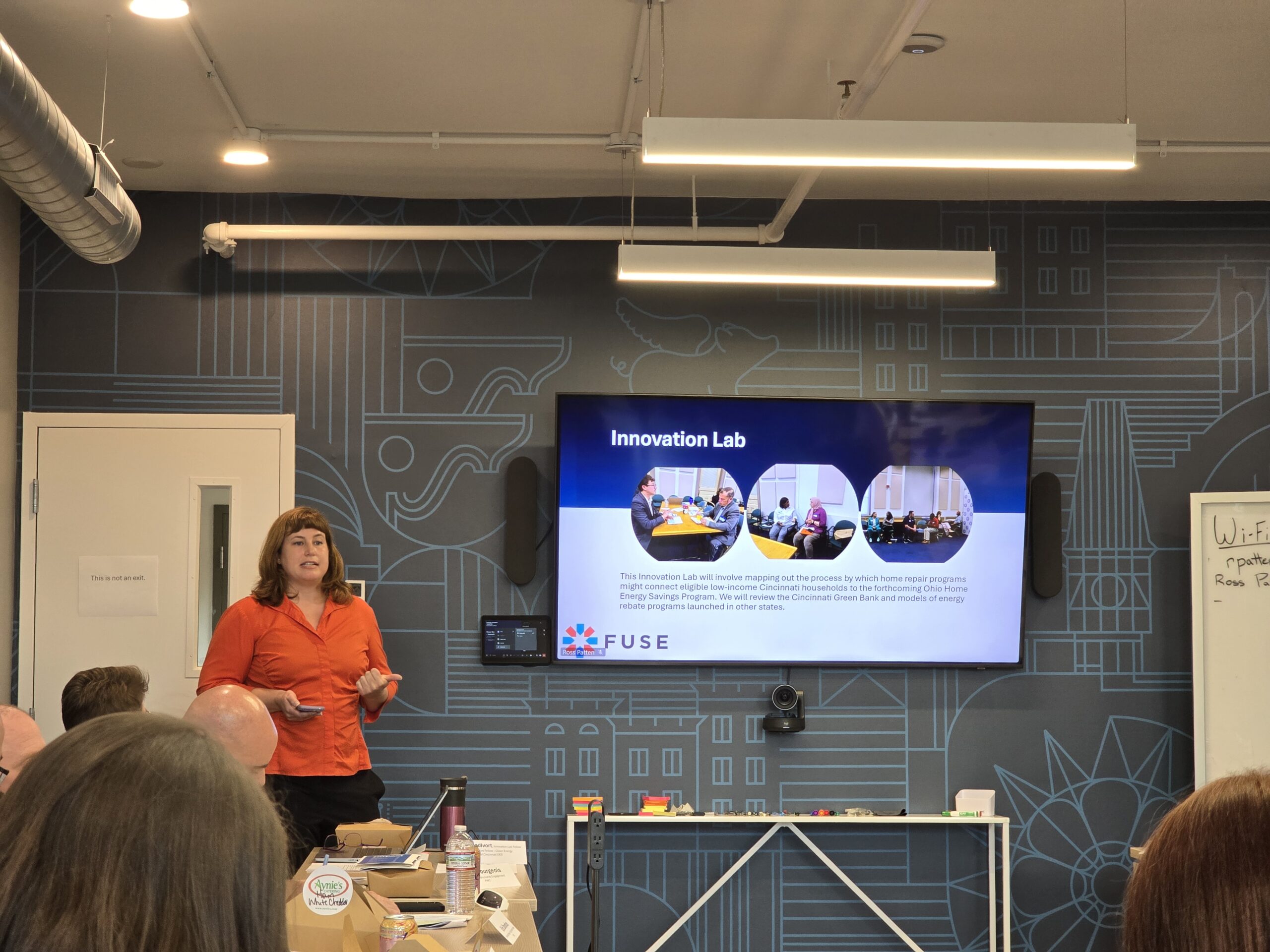This article was written by FUSE Executive Fellow Nikki Vandivort
Creating Pathways To Home Energy Savings

Serving on the City of Cincinnati’s Energy Team as a FUSE Executive Fellow, I have contributed my federal climate policy expertise and aided in connections with diverse community stakeholders and organizations as a member of the Cincinnati Green Bank (CGB) Steering Committee. Our definition of a Green Bank is “a regional effort to drive equitable investment into clean energy by coordinating public policy, technical assistance, and access to grants and incentives with innovative public/private financing solutions”. The foundation of the CGB is a formal collaboration across participating organizations to bring green bank solutions to lower barriers to adoption of energy saving technologies and clean energy generation for our community.
Through my work, I have bridged connections to funding opportunities and collaborated with Steering Committee members to imagine how the Cincinnati area could get ready to deploy significant investments focused on energy efficiency, weatherization, and clean energy for single-family and multi-family homes.
The Innovation Lab we held was focused on finding ways our community could leverage the forthcoming Ohio Home Energy Savings Program (HESP), a $249 million federal-to-state allocation to fund home energy rebates through the Inflation Reduction Act (IRA). This program is designed to provide rebates on energy efficiency, weatherization, and electric appliances (including heat pumps) to single-family and multi-family households, with increased rebate values for low and moderate-income households. Ohio’s program has received conditional approval from the U.S. Environmental Protection Agency. The City and its CGB Steering Committee partners aim to position the Cincinnati area to be able to immediately connect eligible households to these significant cost-saving incentives when the rebate program launches.
Connecting Households To Resources
In preparing to rapidly connect local households to the rebate program incentives, it is important to consider the system that would support the work, from skilled local contractors to existing critical home repair programs and trusted community nonprofits. It is also critical to recognize feelings of government mistrust that potentially eligible households may have, as well as the capacity of those households to apply for and see a project through a potentially lengthy, albeit beneficial process. In addition, financial considerations must also be addressed in order to support participants, such as small contractors or those households that are only eligible for partial rebates.
The FUSE Innovation Lab was an ideal setting to establish connections, think through the rebate process start-to-finish, and develop a shared vision with local stakeholders. The Lab was hosted and planned by CGB Steering Committee members with the amazing aid of our FUSE-sponsored facilitator, Grady Powell from OpenFields. It brought together members of the Cincinnati Green Bank steering committee (City of Cincinnati, Hamilton County, Cincinnati Development Fund, The Port of Greater Cincinnati Development Authority), organizations offering local home repair programs (People Working Cooperatively, Habitat for Humanity of Greater Cincinnati, Council on Aging of Southwestern Ohio, LISC of Greater Cincinnati), as well as Fifth Third Bank and North Side Bank & Trust, which operates Hamilton County’s lower-interest Home Improvement Loan Program. The Ohio Department of Development (ODOD), the State agency developing the rebate program, was scheduled to attend the Innovation Lab but was unable to at the last minute. Luckily, it expressed a desire to hold a debrief of the Lab, which we hope will convey some key learnings from stakeholders that will help the rebate program launch and run smoothly.

Building Knowledge, Mapping Challenges, Identifying Opportunities
In preparation for the Innovation Lab, I collected and shared short biographies from each of the anticipated 20+ attendees to familiarize everyone with the work of each local organization, agency, and stakeholder in attendance. I also shared material I had created for the energy incentive webinars I presented regularly during my Fellowship, which details what we know about the Federal rebate program parameters, and proved to be a useful reference. Although we do not have the Ohio program plan yet, we do know what parameters the program must operate within.

Before jumping into the main journey mapping portion of the Lab, we wanted to bring everyone onto the same page about what Green Banks are, what green workforce development efforts were taking place in the City (presented by my concurrent FUSE Executive Fellow colleague, Thanapat Vichitchot), review the federal rebate program parameters, and take a look at the rebate programs in Indiana and Georgia, two states that received full approval of their programs and have already launched. Next, we introduced the work that the home repair programs and financing institutions do, giving a glimpse of how the forthcoming rebate program might be leveraged by these existing organizations to deepen the impact for their clients.
The second portion of the Lab was focused on walking through the major stages of engaging a household for the rebate, beginning with application to the program, moving through the energy audit processes, the actual physical upgrade to the building, to payment of the Contractor. Having multiple perspectives at the table to identify the “who” and “how” aspects of each stage, as well as barriers, opportunities, needs, and questions around the process, was extremely helpful in informing the CGB on how best it might support households and home repair organizations to connect with the forthcoming rebate program. The feedback and highlights will be shared with ODOD in the hopes that it will incorporate some of these considerations in the design of the rebate program.
After the guests left, the CGB Steering Committee spent time debriefing with Grady. The Steering Committee rules by consensus, so in addition to the very helpful perspectives of the home repair program guests, the Lab gave the Committee the focused space and time to discuss and imagine strategies to leverage the rebate incentives.
As a follow-up, I sent a short survey to all Lab participants seeking feedback on the Lab, any input or questions they wanted to share, and whether they were interested in continuing the conversation. The home repair organizations expressed interest in meeting monthly or quarterly to discuss the forthcoming program and strategize how to leverage it and bring the most benefit to their low and moderate-income clients. They also suggested several other organizations that should be brought to the table for future discussions.



Lab Outcomes
Professional facilitation of the conversation was very helpful in getting all the parties present to think about the barriers, needs, and opportunities the rebate program presents, helping move the Green Bank toward eventual program support.
The next steps include a debrief with ODOD, sharing the synthesis of the journey mapping activity we did during the Lab, and completing it in future standing meetings, and perhaps a more formal agreement between the CGB and home repair organizations to support the rollout of this and other energy and cost-saving programs.
Key Takeaways
A few of the key takeaways from the Lab include:
- Trust is essential to making this program work. Low- and moderate-income applicants may need extra guidance, encouragement, and support to take advantage of this program. This is where trusted local organizations and resources like a Navigator program would be very helpful, but local organizations cannot do that work for free.
- Upgrades will likely be led by regional general contractors, who will then subcontract out certain trades. We need to recruit them.
- Contractors will need financial support, especially small, minority, and women-owned businesses that cannot float projects on their own and wait for reimbursement. They will need to be kept busy with a steady workflow and engaged with the program.
- Gaps may need to be addressed locally, such as how to handle future maintenance calls and the need to repair or replace broken appliances.
Federal funding delays have been a major impediment during my Fellowship, and they have impacted the Green Bank efforts and HESP, as well. In addition to HESP, some programs were initially anticipated to launch in 2024 but have since been delayed. Others were awarded and had begun supporting projects when funding was frozen and then rescinded in 2025. However, with the recent launch of the Indiana Home Energy Saver Program in May 2025, I am hopeful a similar program will launch in Ohio in late 2025 or early 2026. The attitudes of the attendees of the Innovation Lab ranged from skeptical to cautiously optimistic. Whether or not Ohio rolls out its home energy savings program or not, the Innovation Lab provided a space to strengthen connections across the finance, government, and home repair nonprofit ecosystem, which is an asset to future energy programs offered locally through these stakeholders and/or the Cincinnati Green Bank.
Thank you very much to FUSE for sponsoring and supporting the Innovation Lab, to the members of the CGB Steering Committee who helped plan the agenda, to the Cincinnati Development Fund for hosting the event at their office and providing lunch, and to our gracious attendees who shared their time and were deeply engaged during the Lab. I look forward to what we can do together to connect Cincinnati households to the Ohio Home Energy Savings Program!



